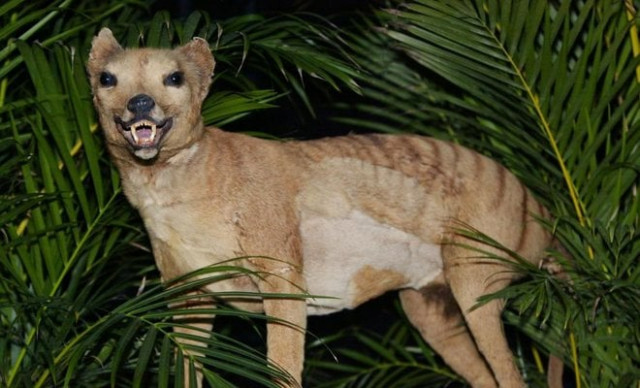Tasmanian tiger doomed long before humans came along
The research revealed the creature began to undergo a decline in genetic diversity more than 70,000 years ago

Tasmanian tiger doomed long before humans came along. PHOTO: AFP
Scientists genetically mapped the animal -- also known as a thylacine -- using the genome of a pup preserved more than a century ago in a jar.
The research revealed the creature began to undergo a decline in genetic diversity more than 70,000 years ago, leaving it less resilient to environmental change even before Aborigines are believed to have first inhabited the continent 65,000 years ago.
"Our hope is that there is a lot the thylacine can tell us about the genetic basis of extinction to help other species," said University of Melbourne biologist Andrew Pask, co-author of a study published in Nature Ecology and Evolution.
Pask added the research may eventually enable scientists to clone the Tasmanian tiger and bring it back from the dead.
India man-eating tiger dies after being electrocuted
"As this genome is one of the most complete for an extinct species, it is technically the first step to 'bringing the thylacine back', but we are still a long way off that possibility."
The animal was once widespread across Australia, but was wiped out on the mainland around 3,000 years ago, having likely succumbed to drought.
They survived in the southern island state of Tasmania until 1936 when the last known one died in captivity at Hobart Zoo after the species was hunted to extinction in the wild.
Scientists found the genetics of the animal to be more closely related to fellow Australian marsupial the Tasmanian devil than the dog-like dingo with whom it shared many physical features.
The physical likeness of the two animals is among the best examples of what scientists call "convergent evolution", whereby animals distantly related evolve to look similar as they adapt to the same environment.
Celebrity elephant kills owner in Thailand
In the case of the tiger and dingo, their head and body developed similarly due to their meat-eating hunting techniques, even though the marsupials' ancestry diverged genetically from the dog-like animals known as canids about 160 million years ago.
"And when we looked at the basis for this convergent evolution, we found that it wasn't actually the genes themselves that produced the same skull and body shape, but the control regions around them that turn genes 'on and off' at different stages of growth," Pask added.
"This reveals a whole new understanding of the process of evolution. We can now explore these regions of the genome to help understand how two species converge on the same appearance, and how the process of evolution works."



















COMMENTS
Comments are moderated and generally will be posted if they are on-topic and not abusive.
For more information, please see our Comments FAQ